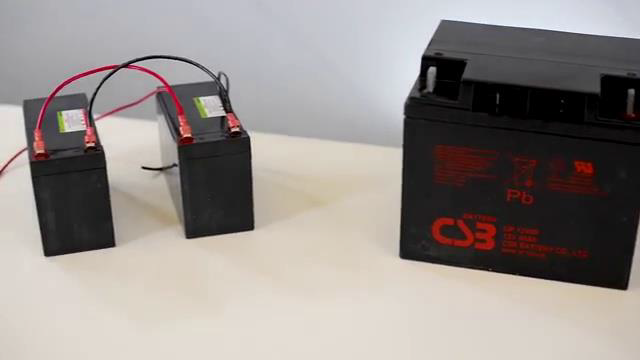Wiring_Batteries_Series_vs__Parallel_(Part_One).pdf
How to wire industrial batteries in series or in parallel, and what the benefits and disadvantages are of each method. For more information about circuits wired in series or in parallel, please see our video discussing this in more detail. For the purpose of this video we want to show you has this applies to batteries. When thinking about how to wire multiple batteries, there are a few things that we need to consider.
First is what is the voltage requirement of our load. Most batteries produce 12 volts DC. So, if our load requires more than 12 volts, this needs to be taken into consideration when wiring our system. This can also dictate how many batteries are needed in our system.
We also need to consider the capacity of our battery, or how long the battery will last. This is determined by the amp hour rating of the battery. Amp-hours is how we determine how long a battery will last running at 1 amp.
For example, if we have a 20 amp-hour battery, that battery will power any load at 1 amp for 20 hours. Or, it will last for 10 hours, when the load is drawing 2 amps, or 1 hour at 20 amps. So depending on the amp-hour rating of our battery, as well as the amperage requirements of our load we can determine how long our battery can provide power.
Go to Part 2 of Wiring Batteries series
Transcript:
[0m:4s] Hi I'm Josh Bloom, welcome to another video in the RSP Supply education series. Today we're going to be talking about how to wire batteries and either series or parallel and the criteria we might look for when selecting a battery.
[0m:16s] When trying to decide how to wire a battery or what battery we would like to select, there are a few considerations we need to think about. One of the first things we want to think about when trying to select how to wire a battery or battery selection is the voltage requirement of our load. Most batteries produce 12 volts, DC, so if our load requires more than 12 volts, this can dictate how many batteries we use and how we wire those batteries.
[0m:39s] We also need to consider the capacity of the battery that we're going to be using.
[0m:43s] This is measured in what we call AMP hours. Each battery has a specific AMP hour rating. For example, we can have a battery that has a 10 AMP hour rating. What this means is that battery will supply power at one app for 10 hours, or another way to look at it might be
[1m:1s] that 10 AMP hour battery can supply 10 amps for one hour or any variation in between.
[1m:7s] In referring to AMP hours or capacity of a battery, a few things that dictate what that might be is how many batteries we have wired together and how that happens and also the size of the actual battery itself. In this case, you can see I've got a few different sizes of batteries here. We have a large battery producing 12 volts DC. We also have a small battery producing 12 volts DC. The main difference here is capacity or the AMP hour rating.
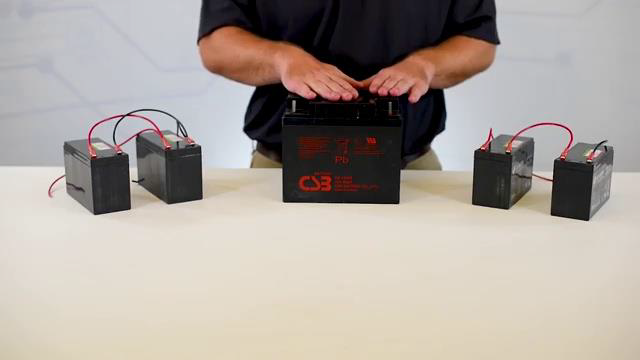
[1m:30s] In this case, we have a small battery with A-7-5 AMP hour rating. And we have a large battery with a 40 AMP hour rating.
[1m:37s] Once we have determined the voltage requirements and capacity or AMP hour requirements of our system, we can then determine how many batteries we need to use in the specific wiring configuration for that particular system. First let's start with voltage. Let's assume we have a basic 12 Volt system. In this case, we would only need one 12 Volt battery. Let's assume we have now a 24 Volt system. In this case, we would need two 12 Volt batteries to produce that 24 volts. Let me demonstrate how we would wire these two batteries together in order to produce 24 volts. For example, in this particular setup, we have two 12 Volt batteries. n order to produce the 24 Volt that is required, we need to wire these batteries in series. Let me demonstrate how we're going to do that.
[2m:22s] We first take our negative terminal on battery one and wire that to our DC negative bus. Then on the same battery, we wire the positive terminal to the negative terminal on battery two.
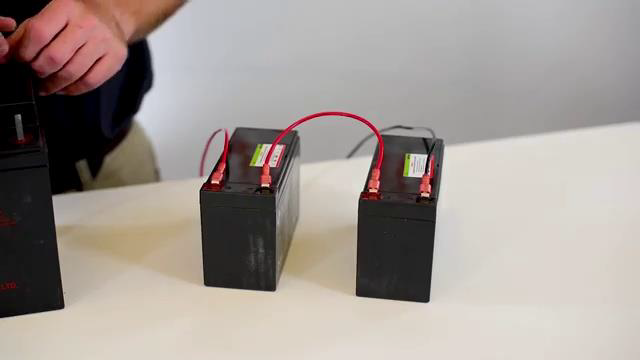
[2m:35s] We then take the positive terminal on battery two and wire that to our load.
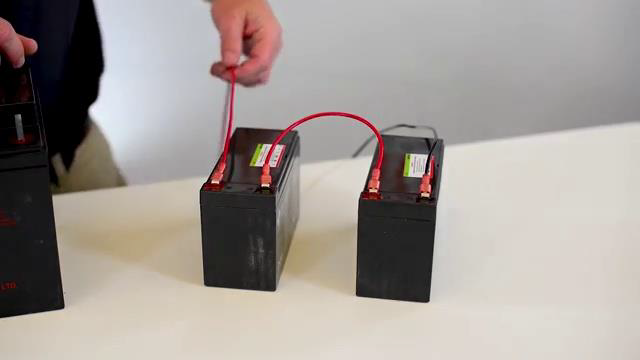
[2m:41s] So keep in mind, when wiring in series, we are simply increasing the voltage of our system. However, this does not increase the AMP hour rating or capacity of our system.
[2m:50s] So we have two batteries wired in series that increase the voltage to 24 volts,
[2m:55s] but we still have a 7.5 AMP hour rating.
[2m:58s] So let's look at another example where we need to keep the voltage the same but we need to increase our capacity or AMP hour rating.
[3m:6s] In this scenario, we have two 12 Volt batteries. In order to increase our capacity, we need to wire these batteries in parallel. Let me demonstrate how we do that.
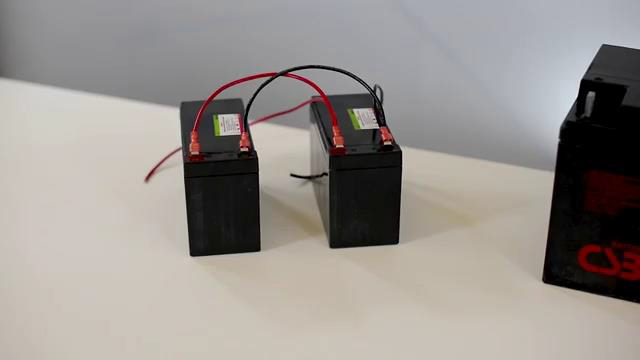
[3m:16s] On battery one from the DC negative bus, we wire to the negative terminal.
[3m:22s] From battery one, we wire also to the negative terminal on battery 2.
[3m:27s] The positive terminal on battery one is wired to our load as well as to the positive terminal on battery two. So again, in parallel, we wire negative to negative and positive to positive. This will increase the capacity or AMP hour rating or system, but it will not increase the voltage rating of our system.
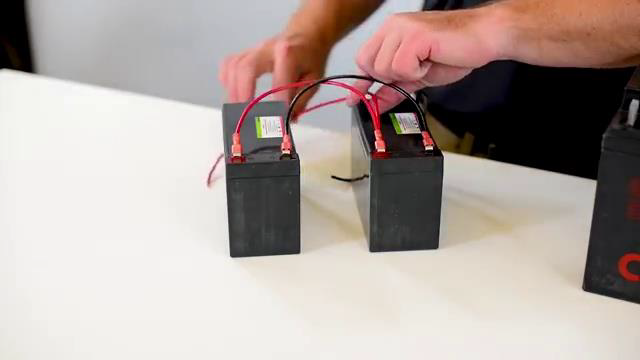
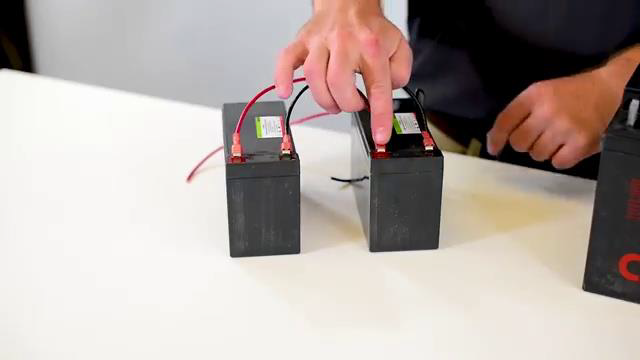
[3m:46s] So, just remember, when we wire in series, we increase voltage. That's positive to negative.
[3m:53s] When we wire in parallel, we increase capacity. That's positive to positive and negative to negative.
[3m:59s] Keep in mind there are more advanced configurations where we can increase both the voltage and capacity which we cover in another video.
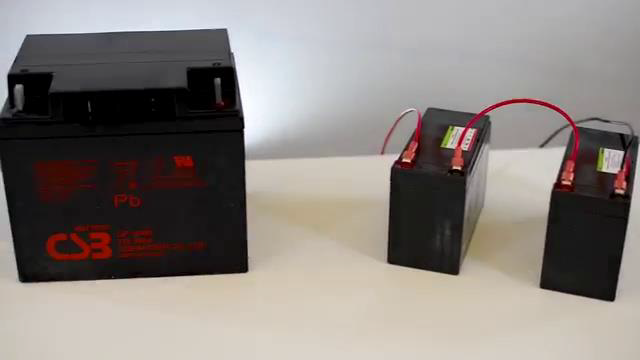
[4m:7s] For a full line of batteries or thousands of other products, please go to our website. For more information or other educational videos, go to RSPSupply.com, the Internet's top source for industrial hardware. Also, please don't forget: like and subscribe.
